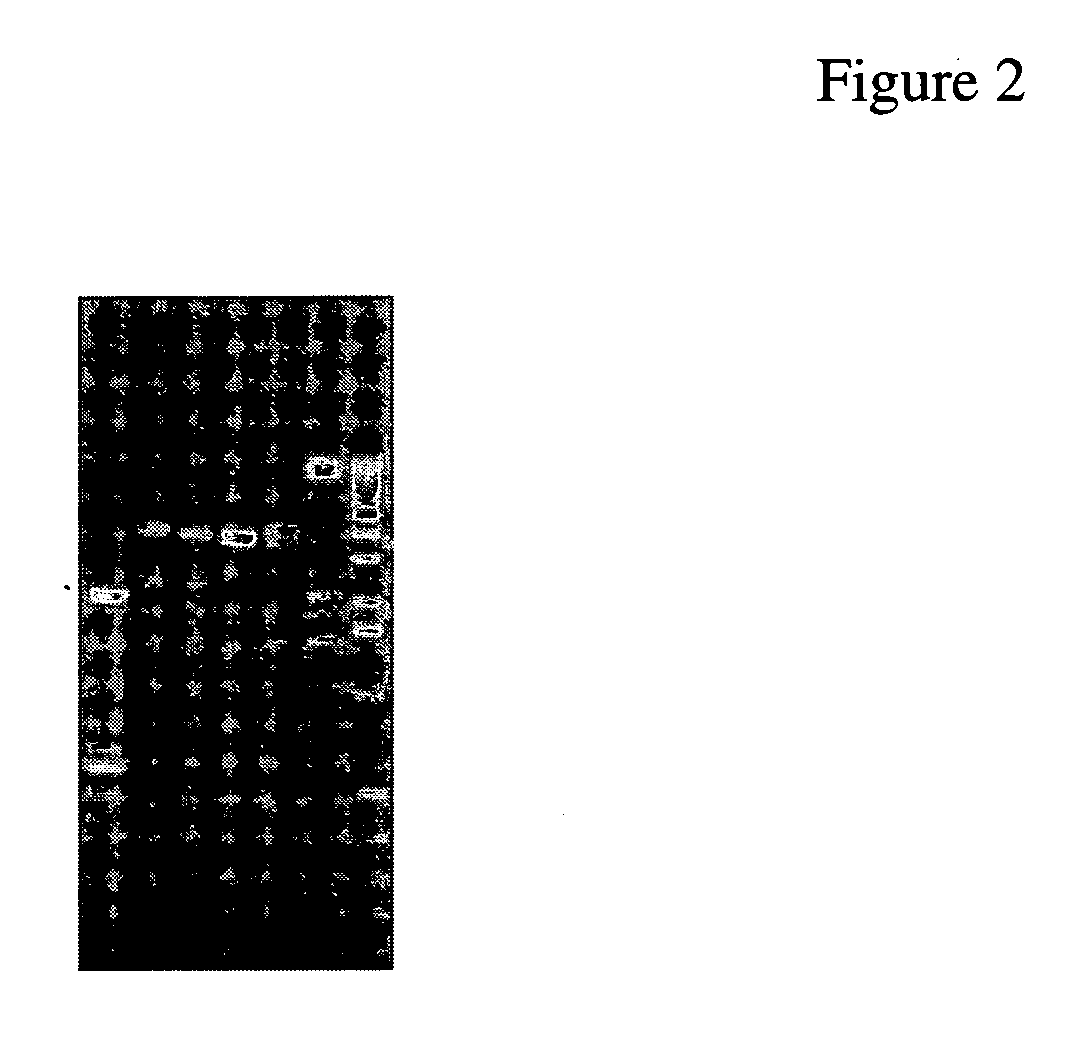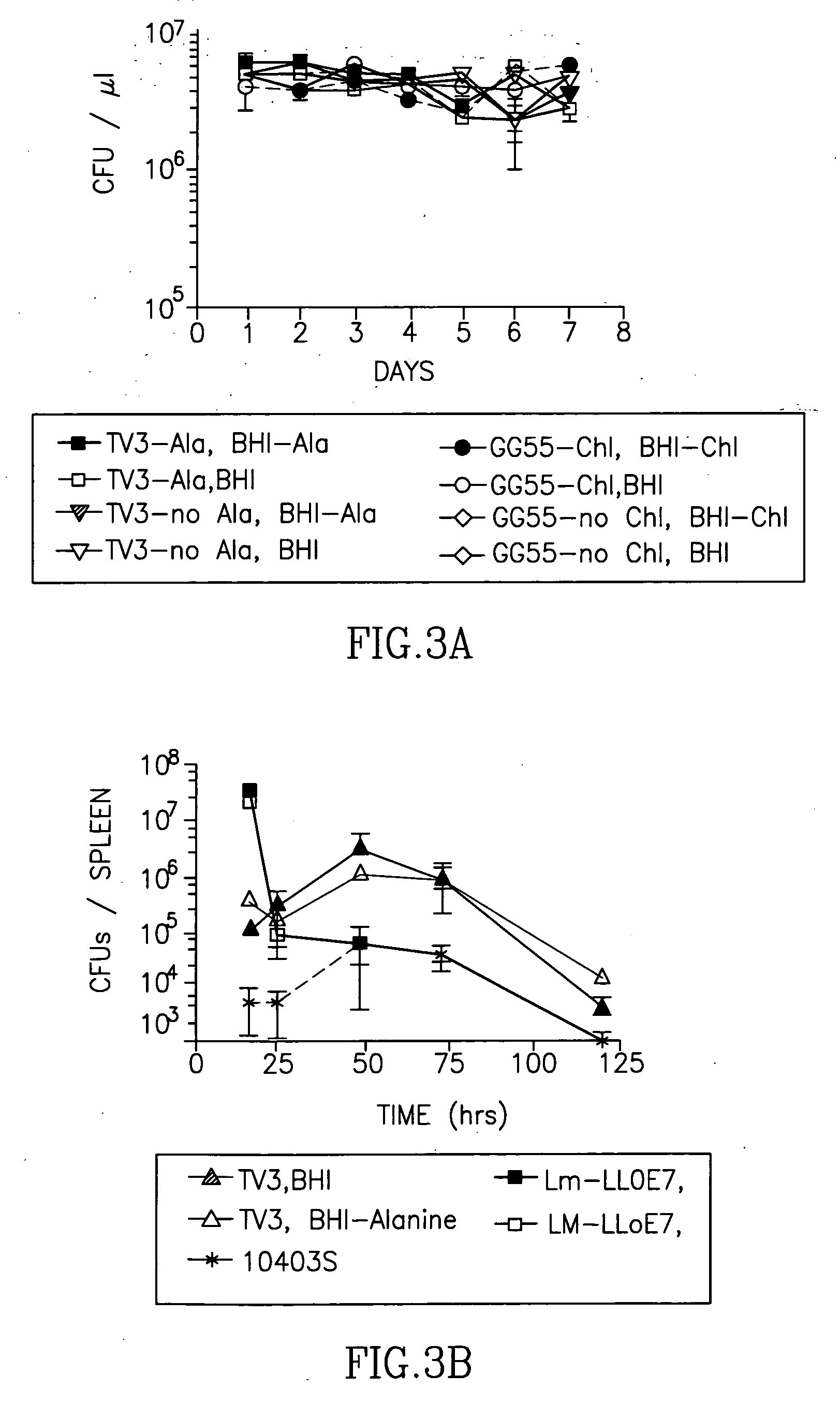Methods for constructing antibiotic resistance free vaccines
a technology of antibiotic resistance and vaccines, applied in the field of listeria vaccine strains, can solve the problems of immune response, ineffective in combating intracellular organisms or tumors, and traditional vaccine strategies may not be completely effectiv
- Summary
- Abstract
- Description
- Claims
- Application Information
AI Technical Summary
Benefits of technology
Problems solved by technology
Method used
Image
Examples
example 1
Elicitation of Immune Responses by Bacterial Vectors Carrying Episomal Antigen-Encoding Constructs
Materials and Experimental Methods
Transformation and Selection
[0093]E. coli strain MB2159 was used for transformations, using standard protocols. Bacterial cells were prepared for electroporation by washing with H2O.
Bacterial Culture and In Vivo Passaging of Listeria
[0094]E. coli were cultured following standard methods. Listeria were grown at 37° C., 250 rpm shaking in LB media (Difco, Detroit, Mich.). +50 ?g / ml streptomycin, and harvested during exponential growth phase. For Lm-LLOE7, 37 ?g / ml chloramphenicol was added to the media. For growth kinetics determinations, bacteria were grown for 16 hours in 10 ml of LB+antibiotics. The OD600nm was measured and culture densities were normalized between the strains. The culture was diluted 1:50 into LB+suitable antibiotics and D-alanine if applicable.
Passaging of LM in Mice
[0095] 1×108 CFU were injected intraperitoneally (ip.) int...
example 2
A Plasmid Containing an Amino Acid Metabolism Enzyme Instead of an Antibiotic Resistance Gene is Retained in E. coli and LM Both In Vitro and In Vivo
Materials and Experimental Methods
Construction of Antibiotic Resistance Factor Free Plasmid pTV3
[0105] Construction of p60-dal cassette. The first step in the construction of the antibiotic resistance gene-free vector was construction of a fusion of a truncated p60 promoter to the dal gene. The LM alanine racemase (dal) gene (forward primer: 5′-CCA TGG TGA CAG GCT GGC ATC-3′; SEQ ID NO: 8) (reverse primer: 5′-GCT AGC CTA ATG GAT GTA TT TCT AGG-3′; SEQ ID NO: 9) and a minimal p60 promoter sequence (forward primer: 5′-TTA ATT AAC AAA TAG TTG GTA TAG TCC-3′; SEQ ID No: 22) (reverse primer: 5′-GAC GAT GCC AGC CTG TCA CCA TGG AAA ACT CCT CTC-3′; SEQ ID No: 23) were isolated by PCR amplification from the genome of LM strain 10403S. The primers introduced a PacI site upstream of the p60 sequence, an NheI site downstream of the dal sequence ...
example 3
Plasmids Containing a Metabolic Enzyme do not Increase the Virulence of Bacteria
Materials and Experimental Methods
[0119] 4×109 CFU of Listeria were thawed, pelleted by centrifugation (1 minute, 14000 rpm) and resuspended in 100 ?l PBS, pH 5.5 with 1 M cysteine. Bacteria were serially diluted 1:2 and incubated for 45 μminutes at 37° C. in order to activate secreted LLO. Defibrinated total sheep blood (Cedarlane, Hornby, Ontario, Canada) was washed twice with 5 volumes of PBS and three to four times with 6 volumes of PBS-Cysteine until the supernatant remained clear, pelleting cells at 3000×g for 8 minutes between wash steps, then resuspended to a final concentration of 10% (v / v) in PBS-Cysteine. 100 ?l of 10% washed blood cells were mixed with 100 ?l of Listeria suspension and incubated for additional 45 minutes at 37° C. Un-lysed blood cells were then pelleted by centrifugation (10 minutes, 1000×g). 100 ?l of supernatant was transferred into a new plate and ...
PUM
| Property | Measurement | Unit |
|---|---|---|
| temperatures | aaaaa | aaaaa |
| size | aaaaa | aaaaa |
| pH | aaaaa | aaaaa |
Abstract
Description
Claims
Application Information
 Login to View More
Login to View More - R&D
- Intellectual Property
- Life Sciences
- Materials
- Tech Scout
- Unparalleled Data Quality
- Higher Quality Content
- 60% Fewer Hallucinations
Browse by: Latest US Patents, China's latest patents, Technical Efficacy Thesaurus, Application Domain, Technology Topic, Popular Technical Reports.
© 2025 PatSnap. All rights reserved.Legal|Privacy policy|Modern Slavery Act Transparency Statement|Sitemap|About US| Contact US: help@patsnap.com



